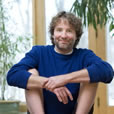“Mind-body integration is more than a personal health strategy. It is a movement of consciousness that can change the world.”
― Matthew Sanford
 At 13 years old, Matthew Sanford was paralyzed from the chest down in an accident that killed his father and his sister. Trauma, he says, happens not just to an individual but to a whole family. His body sustained injuries that required multiple surgeries, extensive rehab, time, and the deep support of family and friends. Twelve years after the accident, he started yoga to relieve the chronic pain in his body. Today, he is a yoga instructor not just for those that have survived trauma but also for able-bodied individuals. I met him in a workshop several years ago, and he is a remarkable presence. Teaching yoga from his wheelchair, he is a repository of wisdom with a unique perspective on the mind-body connection and healing gained from his survival of trauma. He tells the story in his book, Waking: A Memoir of Trauma and Transcendence.
At 13 years old, Matthew Sanford was paralyzed from the chest down in an accident that killed his father and his sister. Trauma, he says, happens not just to an individual but to a whole family. His body sustained injuries that required multiple surgeries, extensive rehab, time, and the deep support of family and friends. Twelve years after the accident, he started yoga to relieve the chronic pain in his body. Today, he is a yoga instructor not just for those that have survived trauma but also for able-bodied individuals. I met him in a workshop several years ago, and he is a remarkable presence. Teaching yoga from his wheelchair, he is a repository of wisdom with a unique perspective on the mind-body connection and healing gained from his survival of trauma. He tells the story in his book, Waking: A Memoir of Trauma and Transcendence.
Yoga
Yoga is a practice that comes from ancient India. The word “yoga” from the Sanskrit means “yoke” or “union” and refers to the union of mind, body, and spirit. “Yoga” in the Western world often refers to only the physical practices and poses. Others see only the cultural context that the practices of yoga developed within, and view it as a religious or cult practice. However, at the core of yoga is a philosophy of union of the mind, body, and spirit. Yoga is an embodiment practice, connecting mind and body.
“I had to learn the [yoga] poses from the inside out.”
Paralysis took away movement and sensation below his legs. Doctors told him (incorrectly) that he would never feel anything below his chest. Through yoga and reconnecting mind awareness to body, he has rediscovered “sensation” in his lower body. Our medical model is slowly integrating the concept of an energy body, the spirit of the body. Other models of Eastern medicine, include the concept of energy that the yogis call prana and the Chinese call chi. Without the “physical sensation” (his spinal cord is severed), Matthew Sanford discovered an “energetic sensation” through yoga. Today, he says, “My mind can feel into my legs.”
“Yoga can travel through any body.”
― Matthew Sanford on Adaptive Yoga for disabilities
Because of severe trauma and pain, his mind had left his body in a form of disassociation. This is what he needed to do to survive at the time. However, consciousness is not just presence of the thinking mind. He had learned to live in his mind and only the upper part of his body. As he rediscovered more body awareness, he found that there were “physical memories” (“body memories”) that manifested as chronic pain and post-traumatic flashbacks that yoga slowly helped to relieve.
“Paralysis has been a teacher of presence to me.”
